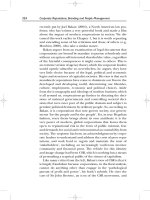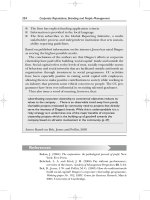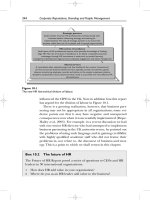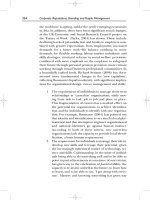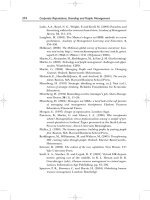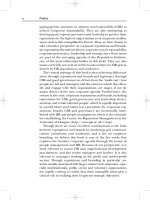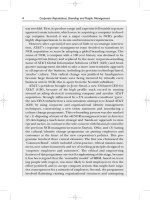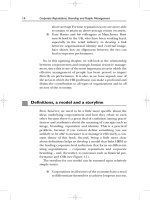Tài liệu Corporate Reputations, Branding and People Management 9 docx
Bạn đang xem bản rút gọn của tài liệu. Xem và tải ngay bản đầy đủ của tài liệu tại đây (132.37 KB, 10 trang )
Nevertheless, it is also interesting to note that RBS, like HSBC
before it, is moving slowly to becoming a ‘branded house’, by
endorsing its major businesses with the RBS logo and investing
heavily in the RBS (rather than Royal Bank of Scotland) brand
at major international sporting events and other forms of pro-
motion, perhaps with a view to establishing a more corporate
feel to its image (see also Chapter 7).
Corporate reputations
As we noted in Chapter 1, the concepts of branding and cor-
porate reputations have a common origin in their focus on the
image of organizations. Furthermore, as we have already noted
in this chapter, branding specialists sometimes use the term
reputation to refer to key attributes of brands. Nonetheless,
one of our central key contentions in this book is that the idea
of a reputation is a more distinctive, root concept, less redolent
of communications ‘spin’ than branding, is plural in its out-
look and addresses a wider range of stakeholders and agendas.
These include CSR, diversity and governance, which are impor-
tant topics in this book. Thus, for our purposes, reputation is a
broader, more inclusive and more useful focal concept than
branding, and has a distinctive meaning which we will discuss
later.
Like branding, corporate reputations have become the sub-
ject of a number of influential press ratings, including Fortune
Magazine, Asia Business and The Financial Times, which have lent
it credibility with the general public and other stakeholders.
As we also indicated in Chapter 1, positive reputations can lead
to significant financial advantages. However, reputations have
also become notable because of their ability to help defend
an organization when it encounters adverse publicity. For
example, Johnson & Johnson was able to survive the catastrophic,
malicious tampering with Tylenol, one of its core products, by
recovering well from a small decline in its market value because
of the company’s past reputation for good business principles
and socially responsible behaviour – its reputational capital
(Haig, 2004). Other companies, when facing similar disasters,
64 Corporate Reputations, Branding and People Management
have suffered more severe and sustained declines in market
value because they did not have the depth of reputational cap-
ital to sustain them through their crises (Fombrun and Van Reil,
2003). As we write, Merck, the US pharmaceutical company, is
in the middle of a crisis. It had £27 billion wiped off its share
value following the successful legal action taken against it for its
now infamous marketing of Vioxx, the anti-inflammatory drug
that was associated with heart problems (Economist, 2005b).
Corporate reputation is also important in the wake of the cor-
porate governance and financial irregularities of Enron,
WorldCom and Andersen Consulting in the USA, Parmalat in
Italy, Shell in the UK and Mannesmann and Volkswagen in
Germany because it acts as a form of ethical control by creating
a culture of ethical values and standards of behaviour that help
guide employees in their dealings with customers, clients and
governments and answer the question: Would my actions be in
line with the organization’s reputation? Clearly in the case of
the most recent of these scandals, the answer would be negative.
Approaches to reputation management
So, what do we understand by corporate or organizational repu-
tation(s)? Like identity, image and brands, this whole area is
confused by different people using the term in slightly different
ways. For example, some writers and practitioners treat reputa-
tion and image as the same thing, others suggest that they are
different but closely related, while yet others treat reputations
as a combination of image and identity. Following Whetten and
Mackey (2002), we have already made an initial attempt to
define reputation in Chapter 1 as an organization’s biography,
the official and unofficial assessments of the organization by sig-
nificant outsiders. This is distinguished from its autobiograph-
ical image, its own account of how it wants to be regarded. In
slightly more formal terms, reputation can be defined as the
mirror of image: ‘the feedback from others concerning the
credibility of an organization’s self-definition’ (p. 400).
There are some important implications of this definition.
First, outsiders only have partial information on which to base
Chapter 2 Managing corporate brands and reputations 65
their assessments and, thus, what they come to expect of an
organization. Second, they are likely to make assessments on
the basis of what they value and expect to find in the projected
image. As we shall see, however, there is some disagreement
over whether an organization enjoys a reputation singular or
reputations plural. Let’s look at four slightly different interpret-
ations, each of which has a contribution to make to the reputa-
tion management field.
Strategic stars
In Chapter 1 we noted the work of two leading writers, Mary Jo
Hatch and Majken Schultz (2002), who have significantly influ-
enced practitioners. They see reputations resulting from the
interaction between the objective and subjective evaluations of
existing and potential stakeholders. These evaluations com-
prise three interrelated dimensions:
■ informal interactions among stakeholders, for example
through sales meetings, employee storytelling or
accounts from satisfied or dissatisfied customers; these
incidents strongly influence an organization’s reputa-
tion or external image but are largely uncontrollable
■ the business press, such as the rankings of the
best places to work and industry press ratings of
organizations
■ potential stakeholders, such as possible recruits,
shareholders and other funders, government organ-
izations and the community at large.
Hatch and Schultz (2001) have developed from earlier, more
academic, work a practitioner-orientated tripartite framework
based on corporate image, corporate vision and organizational
culture. By image they mean the outside world’s or stakeholder
impression of the company, including customers, shareholders,
the media and general public. Vision refers to what senior man-
agers aspire to for the company and culture refers to the organ-
ization’s key values, behaviours and attitudes (p. 130). Hatch
and Schultz have argued that, to build an effective corporate
66 Corporate Reputations, Branding and People Management
reputation, organizations must ensure that these three elem-
ents of an organization, the three strategic stars, need to be
aligned. According to these authors, misalignments occur when
there are significant gaps in the following areas:
■ The vision–culture gap results from senior managers
moving the company in a direction that employees
either do not understand or do not support. Some-
times this is a consequence of the pace of change, in
which the vision is too stretching, whereas at other times
it results from visions that sit uneasily with ethical or
traditional values, such as the attempted re-branding of
the UK Post Office to Consignia or British Airway’s
attempt to re-brand itself as ‘the world’s favourite air-
line’ by dropping the union jack from its tailfins and
adopting diverse motifs from different countries to
reflect its new global image. Both of these attempts
failed badly because they did not fit the established cul-
ture and traditions of the organization, nor did they
command the respect of existing employees (Miller
and Muir, 2004). Another illustration of this gap one of
us researched with a close Chinese colleague is drawn
from joint ventures between European and Chinese
companies. These Sino-foreign joint ventures all had
problems merging the Chinese ways of doing HR,
embedded in the ‘Iron Rice-Bowl’ culture and previ-
ously limited discretion over hiring, firing and set-
ting wages, with inwardly investing companies’ more
market-oriented visions and practices (Zhang and
Martin, 2003).
■ The image–culture gap usually results from organiza-
tions not putting into practice their brand values and
leads to confusion among customers about the com-
pany’s outside image. This gap is usually most appar-
ent when employees’ views of the company are quite
different from those held by customers. One example
cited in a Harvard Business Review article by Peter
Cappelli was of United Parcel Services (UPS). It dis-
covered a major problem in retaining truck drivers
with an in-depth knowledge of local routes. UPS had
Chapter 2 Managing corporate brands and reputations 67
assigned these drivers tedious and difficult work of
loading vans at the beginning of their routes, which
conflicted with the image that drivers had of them-
selves as guardians of a proud heritage of delivery.
Re-assigning this boring work to warehouse staff reduced
driver turnover and increased the alignment between
cultural values and the image of the company.
■ The image–vision gap occurs when there is a mismatch
between the external image of the organization and
senior management’s aspirations for it. Again the British
Airways example to globalize its image by removing the
Union Jack from its tailfins provides a dramatic illustra-
tion of how customers, in this case embodied by the criti-
cisms of Margaret Thatcher and other key customers,
can cause a company to re-think its reputation. This
image–vision gap can also occur at national level. For
example, Australia has taken a long time to shake off its
image to the rest of the world as the ‘land of the long
weekend’, good for holidays but not good for the kinds
of investment needed for it to compete on a global scale
in the new, knowledge-based economy. The fact that it
has done so, and was by 2005 one of the world’s most
competitive economies speaks volumes for the vision of
recent Australian governments and those of its major
companies (World Economic Forum, 2005).
Hatch and Schultz have developed a framework (or ‘toolkit’)
that comprises a set of three areas for diagnosis to assess the
extent of misalignment between these three strategic stars:
1 Who are the stakeholders – what do they want – is the
company communicating with them effectively?
2 Does the company live the values it promotes – is the
vision a compelling one for all sub-cultures?
3 What images do stakeholders associate with the
company – in what ways do employees and stakehold-
ers interact – what is the potential for problems in
these interactions?
These questions do not break new ground in assessing cul-
ture, but they do point to the complex relationships between
68 Corporate Reputations, Branding and People Management
